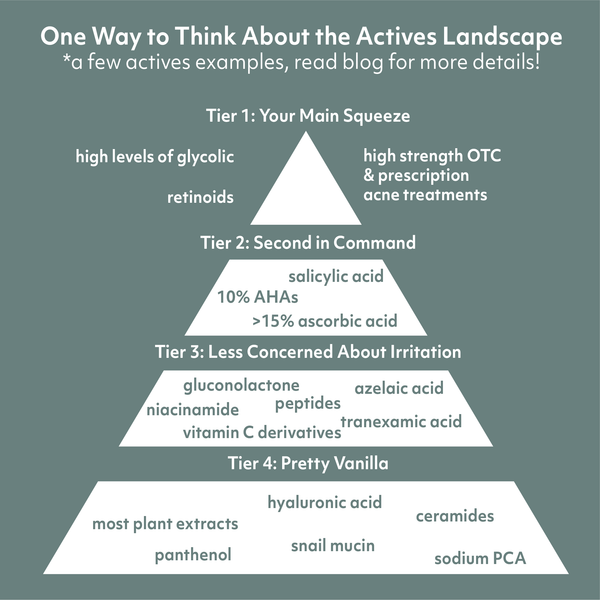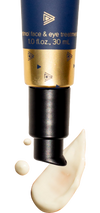One of our most popular articles of Chemist Confessions and the center of a lot of questions is combining actives. In How to Combine Actives Like a Pro Pt. 1 we shared some tips and tricks on how to combine the big 4 actives of retinol, niacinamide, AHAs, and vitamin C. But what about all the other active ingredients? And what does it all really mean when it comes to product layering? It’s finally time for How to Combine Actives like a pro part 2!
*Note: We wrote this for individuals that have a good handle of their fundamental routine: cleanse, moisturizer, sunscreen. If you don’t have this down, refer back to how to build a routine first for guidance.
Remember The Golden Rule of Actives Layering
The Ordinary is probably one of the most influential brands that put common skincare active ingredients into our everyday vocabulary. As chemists, it makes us giddy that instead of talking about “serums” and “essences”, we’re now talking about “glycolic acid” and “peptides”. However, this comes with a lot of confusion and an irresistible desire to pile on everything that might be good for your skin (who doesn’t want it all right??).
But before you go too crazy, just remember that everyone’s skin is different, especially when it comes to active ingredient tolerance. There isn’t a single ingredient cocktail that works for all skin types, nothing is ever that easy in life right? So when it comes to putting together a blend that works for you, the one Golden Rule that applies to everyone is to “patch test and avoid excessive irritation”. For some ingredients like retinol and glycolic acid, you may experience tingling and light shedding, but the goal is never to reach the state of prolonged redness, itching, or even pain.

Welcome to the “Actives Tier”
The skincare actives world can definitely get complicated. Luckily, we’re here to help! The easiest way for us to break it down for you is to put some of these common skincare actives into general “tiers” to help guide your layering decisions. We’ll go at this with a top down approach.

Tier 1: Your Main Squeeze
We consider your prescription acne cocktail, retinol, hydroquinone, and high levels of glycolic acid (+20%) to fall on the tier 1 actives. Most of you only need one product in tier 1 to center the rest of your routine around. Generally combining any products within tier 1 would be for the most tolerant and experienced skin types that really own their actives regimen.
Tier 2: Second in Command (Potential Yellow Flags)
We would put most other exfoliants such as 10%+ AHAs lactic & mandelic acids, high levels of ascorbic acid (~15% and more), and even BHA salicylic acid in this category. They can greatly enhance your tier 1 products, but if your skin is not fully acclimated to your tier 1 product, it can lead you right to irritation town. You would want to introduce these to your main squeeze once your skin has fully acclimated.
Tier 3: Less Concerned About Irritation
A large category of effective yet fairly unlikely to irritate your skin! We consider ingredients such as low levels of vitamin C ascorbic acid, vitamin c derivatives, low levels of lactic acid, gluconolatone niacinamide, tranexamic acid, most peptides, azelaic acid, bakuchiol, and kojic acid in this category. Most people’s skin can tolerate combining a few ingredients within this category no problem. However, still be careful not to go too layer happy here. For example, you can easily find niacinamide and vitamin C at incredibly high levels across multiple product types -- which can easily overwhelm your skin and lead to irritation.
Tier 4: Vanilla Soothers
We consider these active ingredients to be your BFFs with your heavier-hitting, more aggressive ingredients. They are there to help support and soothe your skin barrier. They go with almost all skin types and all ingredients and are highly unlikely to irritate your skin. Some common ingredients we think belong in this category are: hyaluronic acid, centella asiatica, ceramides, microbiome-centric ingredients, panthenol, etc.
Time to layer up!
So let’s use this tier system to help guide your actives layering strategy by looking at a few different skin-arios!
Scenario 1: Just Getting Into Tier 1
Let’s say you’re getting into prescription acne treatment or you want to start using retinol to get that serious anti-aging benefit, the priority is to get skin comfortable using Tier 4 soothers and avoid most other active ingredients. Once you’ve got a good handle on this initial routine, then you can approach products featuring Tier 3 actives with some caution for those added benefits. As hard as it may be, try not to add more than one Tier 3 active in at a time
Scenario 2: “I’m intimidated by Tier 1 actives like retinol. Is there a less aggressive active routine that still gets me results?”
Sure let’s rule out tier 1 for this scenario. So in this case, you would want to combine one good exfoliant combined with one Tier 3 product that suits your skin needs. Keep it to 3 products max (ie. vitamin C serum daily, glycolic serum nightly, and a tranexamic acid-based pigment fighting cocktail serum) and you should be able to steer clear of most irritation.
Scenario 3: I’m overwhelmed! Where do I even start?
If you’re just starting out, we recommend focus on finding your favorite soothing product with Tier 4 ingredients to soothe and bolster your skin barrier. Even though Tier 4 is vanilla, finding the right skin-barrier-whisperer can really pay off in the long run! When you want to test out more aggressive products, these will remain your faithful sidekicks to see you through any unexpected surprises.
A Word On Layering Order
We get a LOT of questions about the correct layering order for different active ingredients. However, this is more about the formulation of the product rather than the active ingredients themselves. Here’s some general layering guidelines to consider:
- Water-based products go first. These are your toners, waters, essences, and most serums. If you enjoy layering multiple water-based products, go from the runniest to the thickest
- Thin, liquid emulsion treatments: These are your milky-looking serums and treatments that usually have a couple oils in the ingredient list.
- The creamy products and moisturizers.
- Where do face oils come in? We typically like to save this for the very end or mixed in with your moisturizers. There isn’t a super strict rule here except to keep it after your water-based products and emulsion treatments
Takeaway
- Retinol, prescription acne cocktails, hydroquinone, and high levels of glycolic acid are considered “Tier 1” products where inexperienced skin actives users may want to tackle just one at a time in your skincare routine
- We consider soothing ingredients such as centella asiatica, bisabolol, many botanical extracts, and barrier function boosting ceramides, microbiome-focused ingredients such as Lactobacillus to be “Tier 4”. They may be basic, but everyone could benefit from a good Tier 4 product!
- Ready to jump in? Checkout some of our recommended products here.
Phew! Hopefully this was a helpful way to dissect and refresh how you think of the treatments and skincare actives landscape. Remember that these actives only work with consistent use and time. When in doubt, build a manageable layering routine and approach new actives step wise to minimize potential irritation. You might be wondering where pH comes into all of this… welp! This is getting long, we’ll be dishing all about pH and skincare in an upcoming podcast episode.







